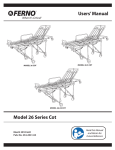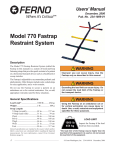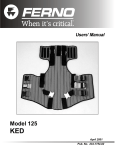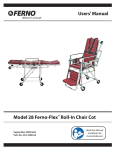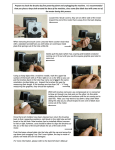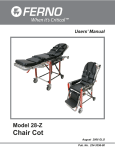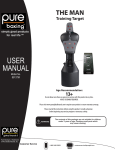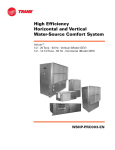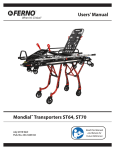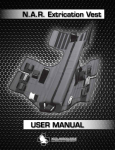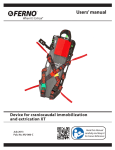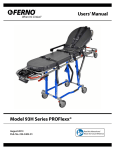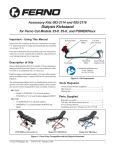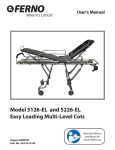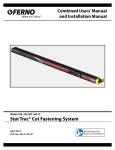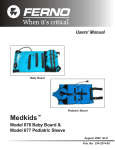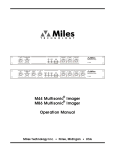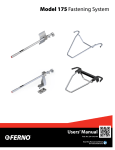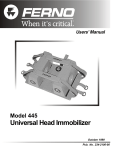Download Using ThE KED® Pro
Transcript
FERNO ® When It’s Critical ® Users’ Manual KED® Pro January 2011 GLO Pub. No. 234-3396-00 Read this Manual and Retain for Future Reference KED® Pro Ferno Technical Support Customer service and product support are important aspects of each Ferno product. Please have the product serial number available when calling, and include it in all written communications. For technical support questions: Telephone (Toll-free) 1.800.733.3766 ext. 1010 Telephone 1.937.382.1451 ext. 1010 [email protected] Ferno Customer Relations For ordering assistance or general information: Canada and the U.S.A. Telephone (Toll-free) 1.877.733.0911 Telephone 1.937.382.1451 Fax (Toll-free) 1.888.388.1349 Fax1.937.382.1191 Internetwww.ferno.com Ferno Australia 11 Johnstone Road Brendale, Queensland 4500 Internetwww.ferno.com.au [email protected] Phone +61 7 3881 4999 Fax +61 7 3881 1125 European Representative Ferno (UK) Limited Stubs Beck Lane, Cleckheaton West Yorkshire BD19 4TZ, United Kingdom Telephone +44 (0) 1274 851999 Fax +44 (0) 1274 851111 Internetwww.ferno.co.uk All Other Locations For assistance or information, please contact your Ferno distributor. If you do not have a Ferno distributor, please contact Ferno Customer Relations: Ferno-Washington, Inc. 70 Weil Way Wilmington, Ohio 45177-9371, U.S.A. Telephone +1.937.382.1451 Fax+1.937.382.6569 Internetwww.ferno.com users’ manual To request additional free users’ manuals, contact Ferno Customer Relations, your Ferno distributor, or visit www.ferno.com. Batch and Serial Number _________________________ Location: Left-hand side lifting handle Disclaimer This manual contains general instructions for the use, operation and care of this product. The instructions are not all-inclusive. Safe and proper use of this product is solely at the discretion of the user. Safety information is included as a service to the user. All other safety measures taken by the user should be within and under consideration of applicable regulations. It is recommended that training on the proper use of this product be provided before using this product in an actual situation. Retain this manual for future reference. Include it with the product in the event of transfer to new users. Additional free copies are available upon request from Customer Relations. Proprietary Notice The information disclosed in this manual is the property of FernoWashington, Inc., Wilmington, Ohio, USA. Ferno-Washington, Inc. reserves all patent rights, proprietary design rights, manufacturing rights, reproduction use rights, and sales use rights thereto, and to any article disclosed therein except to the extent those rights are expressly granted to others or where not applicable to vendor proprietary parts. Limited Warranty Statement The products sold by Ferno are covered by a limited warranty, which is printed on all Ferno invoices. The complete terms and conditions of the limited warranty, and the limitations of liability and disclaimers, are also available upon request by calling Ferno at 1.800.733.3766 or 1.937.382.1451. © Copyright Ferno-Washington, Inc. All Rights Reserved. 2 © Ferno-Washington, Inc 234-3396-00 January 2011 KED® Pro Table of Contents SectionPage SectionPage Ferno Technical Support________________________ 2 Ferno Customer Relations_______________________ 2 1 - Safety Information____________________________ 4 1.1Warning_________________________________ 4 1.2Important________________________________ 4 1.3 Be Aware________________________________ 4 1.4 Bloodborne Disease Notice__________________ 4 1.5 Symbol Glossary__________________________ 4 2 - Operator Skills and Training___________________ 5 2.1Skills___________________________________ 5 2.2Training_________________________________ 5 3 - About the KED® Pro__________________________ 6 3.1Description______________________________ 6 3.2 General Specifications_____________________ 6 3.3Components_____________________________ 7 4 - Using the Features____________________________ 8 4.1 Quick-Release Buckles_____________________ 8 4.2 Shortening Torso and Leg Straps_____________ 8 4.3 Lengthening Torso and Leg Straps____________ 9 4.4 Releasing the Straps_______________________ 9 4.5 Torso Straps____________________________ 10 4.6 Leg Straps______________________________ 11 4.7 Modular Pads ___________________________ 12 4.8 Lifting Handles__________________________ 13 4.9 Head Straps_____________________________ 14 5 - Using the KED® Pro_________________________ 15 5.1 Before Placing the KED® Pro in Service______ 15 5.2 General Guidelines for Use_________________ 15 5.3 Applying the Cervical Collar_______________ 16 5.4 Removing the KED® Pro From the Carrying Case___________________ 16 5.5 Placing the KED® Pro Behind the Patient______ 17 5.6 Applying the Leg Straps___________________ 18 5.7 Wrapping and Positioning the KED® Pro______ 19 5.8 Fastening the Torso Straps_________________ 20 5.9 Securing the Patient’s Head________________ 21 5.10Buckling the Top Strap and Making Final Strap Adjustments ____________ 22 5.11 Using the Shoulder Strap (Optional)__________ 23 5.12Extricating the Patient To a Long Spine Board____________________ 24 5.13Straps for a Standing Take-Down (Optional)___ 25 6 - Adapting The KED® Pro In Special Situations____ 26 6.1 General Guidelines_______________________ 26 6.2 Adapting the KED® Pro for a Pregnant Patient_ 26 6.3 Adapting the KED® Pro for a Pediatric Patient_ 27 6.4 Adapting KED® Pro for an Angulated Neck____ 27 6.5 Adapting the KED® Pro for Use With Monitoring Systems__________________ 27 6.6 Adapting the KED® Pro For Use as a Splint____ 28 6.7 Using the KED® Pro With an Anti-Shock Garment______________________ 28 7 - Storing the KED® Pro________________________ 29 7.1 Storing the KED® Pro_____________________ 29 8 - Maintenance________________________________ 33 8.1 Maintenance Schedule____________________ 33 8.2 Disinfecting and Cleaning the KED® Pro______ 33 8.3 Inspecting the KED® Pro__________________ 33 9 - Parts______________________________________ 34 9.1 U.S.A. and Canada_______________________ 34 9.2Worldwide______________________________ 34 9.3Parts__________________________________ 34 10 - Accessories and Related Products_____________ 34 Training Record_______________________________ 35 Maintenance Record____________________________ 35 © Ferno-Washington, Inc 234-3396-00 January 2011 3 Safety Information KED® Pro 1 - Safety Information 1.1Warning 1.3Be Aware Warning notices indicate a potentially hazardous situation which, if not avoided, could result in injury or death. Boxes like the one below serve as reminders. Be Aware Warning Untrained operators can cause injury or be injured. Permit only trained personnel to apply the KED® Pro. Improper use of the KED® Pro can cause injury. Use the KED® Pro only for the purpose described in this manual. Improper application of the KED® Pro can cause injury. Apply the KED® Pro only as described in this manual. An unattended patient can be injured. Stay with the patient at all times. An unrestrained patient can fall off the spine board or cot and be injured. Use restraints to secure the patient on the spine board and cot. Crossing the shoulder strap over the patient’s neck can choke the patient. Fasten the shoulder strap only as described in this manual. Attaching unapproved equipment or items to the KED® Pro can cause injury. Attach only equipment or items specified in this manual. 1.4Bloodborne Disease Notice To reduce the risk of exposure to bloodborne diseases such as HIV-1 and hepatitis when using the KED® Pro, follow the disinfecting and cleaning instructions in this manual. 1.5Symbol Glossary The symbols defined below are used on the KED® Pro and/ or in this users’ manual. Ferno uses symbols recognized by the International Standards Organization (ISO), American National Standards Institute (ANSI) and the emergency medical services industry. Improper maintenance can cause injury. Maintain the KED® Pro only as described in this manual. Improper parts can cause injury. Use only Ferno parts on the KED® Pro. Modifying the KED® Pro can cause injury and damage. Use the KED® Pro only as designed by Ferno. 1.2Important Important notices emphasize important usage or maintenance information. Important 4 General Warning of Potential Injury 2 Two Trained Operators Required Read the Users’ Manual 250 kg 550 lb 150 kg 330 lb General Use Load Limit Technical Rescue Load Limit © Ferno-Washington, Inc 234-3396-00 January 2011 KED® Pro Operator Skills and Training 2 - Operator Skills and Training 2.1Skills Operators using the KED® Pro need: ● a working knowledge of emergency patient-handling procedures. ● the ability to assist the patient. 2.2Training Operator trainees need to: ● read and understand this manual. ● be trained on the use of the KED® Pro. ● practice with the KED® Pro before using it with a patient. ● record their training information. A sample training record sheet is provided on page 35. ● receive professional instruction and training in Technical Rescue procedures before using the KED® Pro in a Technical Rescue situation. © Ferno-Washington, Inc 234-3396-00 January 2011 Warning Untrained operators can cause injury or be injured. Permit only trained personnel to apply the KED® Pro. Important Technical Rescue procedures require special skills and are potentially hazardous activities. No rescue personnel should attempt such rescue procedures unless they have received professional instruction and training. 5 About the KED® Pro KED® Pro 3 - About the KED® Pro 3.1Description 3.2General Specifications The KED Pro is an emergency patient-handling device designed to aid in the immobilization, short transfer movement, and technical rescue of patients with suspected spinal/cervical injuries. (Technical rescue requires additional equipment and specialized training. See Operator Skills and Training, page 5). Length Opened, flat Rolled, in case Width Opened, flat Rolled, in case Thickness Opened, flat Rolled, in case Weight* Load Limit Technical Rescue Load Limit ® The KED® Pro is for professional use by a minimum of two trained operators. Additional help may be preferred or needed. features ● Color-coded, sewn-in securing straps ● Wraparound head flaps ● Wraparound torso flaps ● Shoulder strap ● Take-down strap (2) ● Head/chin strap (2) ● Leg straps (2) with removable padding ● Modular filler pads (1 large, 2 small) ● Integrated carrying handles ● Carrying case with integrated backpack ● X-ray translucent (except metal buckles) ● Rated for vertical and confined-space rescue (specialized training required) Warning Improper use of the KED® Pro can cause injury. Use the KED® Pro only for the purpose described in this manual. 6 830 mm/ 33 in. 840 mm/33 in. 820 mm/32 in. 245 mm/10 in. 35 mm/less than 1.5 in. 200 mm/8 in. 4.5 kg/10 lbs. 250 kg/550 lb 150 kg/330 lb Note: Weight includes all straps, padding, and carrying case. General specifications are rounded to the nearest whole number. Metric conversions are calculated before rounding the Imperial measurements. For more information, contact Ferno Customer Relations (page 2) or your Ferno distributor. Ferno reserves the right to change specifications without notice. General Use Load Limit 250 kg 550 lb Inspect the KED® Pro if the load limit has been exceeded (See Inspecting the KED® Pro, page 33). Technical Rescue 150 kg 330 lb The KED® Pro is rated for a oneperson lift for vertical and confinedspace rescue. Specialized training is required. © Ferno-Washington, Inc 234-3396-00 January 2011 KED® Pro About the KED® Pro 3.3Components Note: The outside view of the KED® Pro is shown below, with straps in storage configuration. Head/Chin Strap (2) Modular Filler Pad (3) Color-Coded Securing Strap (3) Lifting Handle (3) Wraparound Head Flaps Shoulder Strap Buckle (2) Leg Strap (2) Storage Strap (3) Shoulder Strap (1) © Ferno-Washington, Inc 234-3396-00 January 2011 Take-Down Strap (2) 7 Using the Features KED® Pro 4 - Using the Features 4.1 Quick-Release Buckles The torso and leg-strap buckles are snap-lock and quickrelease, blue-colored metal buckles. Shoulder-strap buckles are white plastic. To fasten, connect the male and female halves of the buckle (Figure 1). A distinctive “click” signals that the buckle is properly fastened. Female Half Male Half Figure 1 Fastening a Buckle To unfasten a buckle, press the release tabs on the female half (Figure 2) and separate the halves. 4.2Shortening Torso and Leg Straps Buckled torso and leg straps are shortened in two stages, first removing excess slack and then snugging/tightening the straps. removing excess slack Figure 2 Unfastening a Buckle When a torso strap is released from its storage position there is a large amount of slack. After fastening the buckle, quickly remove most of the slack by holding the buckle at an angle to the patient with one hand while you pull the hemmed end of the strap with the other hand (Figure 3). Shorten the strap only until you feel the slightest tension. snugging/tightening To prevent twisting or jostling the patient’s torso when snugging/tightening the strap, use the feed-and-pull tightening technique below: Figure 3 Removing Excess Slack 1. Grasp the portion of the strap that lays across the patient’s torso and feed the strap through the buckle with one hand while pulling it through the buckle with the other hand (Figure 4). 2. Repeat until the strap is snug tight. Feed Pull Figure 4 - Feed-and-Pull Tightening Technique 8 © Ferno-Washington, Inc 234-3396-00 January 2011 KED® Pro Using the Features 4.3Lengthening Torso and Leg Straps The technique used for lengthening a strap depends on whether the strap has been buckled. Hold Buckle Male Half at an Angle lengthening a buckled strap To loosen or lengthen a buckled strap, feed excess strap into the buckle with one hand as you lift the buckle at an angle to the KED® Pro with the other hand (Figure 5). lengthening a free strap To lengthen a free strap, hold the male half of the buckle at an angle to the strap with one hand and pull the strap backward through it with the other hand (Figure 6). Figure 5 - Lengthening a Buckled Strap Hold Male Half at an Angle 4.4Releasing the Straps If torso and leg straps were properly configured for storage, they can be released quickly and without tangles when they are needed. For instructions on configuring the straps for storage, see Storing the KED® Pro, page 29 and page 30. Figure 6 - Lengthening a Free Strap torso straps Grasp the male half of the buckle (Figure 7) and pull it from the elastic keeper. Elastic Keeper leg straps If you are going to use the leg straps, leave them in the storage configuration until the KED® Pro has been placed behind the patient but not wrapped and fastened. Free the straps from the hook-and-loop fastener on the KED® Pro head flaps, slide the leg straps from behind the patient, and lay them with the male halves within your reach. If you are not going to use the leg straps, leave them attached in the storage configuration, where they will not interfere with applying the KED® Pro. © Ferno-Washington, Inc 234-3396-00 January 2011 Figure 7 - Releasing a Leg Strap From its Elastic Keeper 9 Using the Features KED® Pro 4.5 Torso Straps The KED® Pro is constructed with three torso straps: top, middle, and bottom. The straps are color coded for easily matching the left and right pieces (Figure 8). Top (Green) Middle (Yellow) When wrapping the torso flaps around the patient, fasten the middle (yellow) strap first, then the bottom (red) strap. Do not fasten the top (green) strap until just before you are ready to transfer the patient to a long spine board. Bottom (Red) Note: The strap buckling and adjusting sequence described below is a preferred method. This procedure may not be practical in all rescue situations. Follow your medical director’s guidelines and local medical protocols. the middle (yellow) strap Fasten the middle (yellow) strap first (Figure 9). Snug the strap only until there is space for 2 or 3 fingers laid flat between the strap and the patient’s torso. You will tighten the straps just before transferring the patient to the long spine board. Torso Strap Buckle (3) Figure 8 - Torso Straps The middle strap evenly secures the greatest possible area of the KED® Pro, providing the greatest patient stability while you finish applying the KED® Pro. If the rescue situation or the patient’s condition requires that you remove the patient from the vehicle more quickly than anticipated, the stability provided by the KED® Pro with only the middle strap fastened, and properly tightened, may be preferable to using no supporting equipment. Follow your medical director’s guidelines on this issue. The Bottom (red) Strap The bottom strap is red in color (Figure 10). Snug the strap until there is space for 2 or 3 fingers laid flat between the strap and the patient’s torso. You will tighten the straps just before transferring the patient to a spine board. the top (green) strap Figure 9 - Middle Strap Fastened Leave the top strap unfastened until you are ready to transfer the patient to the long spine board. This allows the patient to breathe more freely while you finish applying the KED® Pro. Important Attaching ALL straps securely is strongly preferred. However, the patient's condition or rescue situation may require the patient to be removed from the vehicle more quickly than anticipated. Within the time permitted by the patient's and rescue conditions, fasten as many straps as possible, in this order: ● ● ● ● ● 10 Middle strap Bottom strap Leg straps Head/chin straps Top strap Figure 10 - Middle and Bottom Straps Fastened © Ferno-Washington, Inc 234-3396-00 January 2011 KED® Pro Using the Features 4.6Leg Straps Follow your medical director’s guidelines concerning the use of leg straps. The leg straps secure the pelvis to the lower portion of the KED® Pro to stabilize the lower lumbar area. The leg straps also assist in keeping the KED® Pro in place during the process of extricating a patient from a vehicle or during a Technical Rescue operation. leg strap configurations The leg straps can be fastened in a “criss-cross” configuration or a “same-side” configuration, depending on the patient’s condition. For complete instructions, see Applying the Leg Straps, page 18. Figure 11 - Leg Straps Applied In "Same-Side" Configuration Same-Side Configuration (Figure 11): To reduce pressure on the groin area, pass the straps under the patient’s legs and buckle the left strap to the left side of the KED® Pro, and buckle the right strap to the right side of the KED® Pro. Criss-Cross Configuration: Pass the straps under the patient’s legs, then buckle the left strap to the right side of the KED® Pro and buckle the right strap to the left side of the KED® Pro. align the straps with the body midline Whether using the “same-side” or “criss-cross” configuration, you must position the straps as close as possible to the body midline. When buckled straps are correctly positioned, they run straight down from their anchoring points on back of the KED® Pro (Figure 12) before passing beneath the buttocks. Note: Positioning the straps correctly for the “same-side” configuration requires a more focused effort because the tendency during this application is to place the straps away from the midline. Important Figure 12 - Back View Showing Leg Straps Correctly Aligned Parallel With the Body Midline Leg-Strap Anchoring Points To prevent pressure on the groin when using the sameside configuration, take care to correctly align the leg straps parallel with the body midline. Using leg straps during technical Rescue In Technical Rescue situations such as a vertical lift or confined-space rescue, place the leg pads on the leg straps. This will help set the groin area and will minimize pressure against the patient’s groin. © Ferno-Washington, Inc 234-3396-00 January 2011 Body Midline 11 Using the Features KED® Pro 4.7 Modular Pads The three foam-filled pads provided are stored in the large carrying case pocket. The pads can be used singly or in combination to fill a gap between the KED® Pro and the head, cervical collar (or neck, if no collar is used) or shoulders. The pads can be folded, or two pads can be joined using the attached hook-and-loop fastener. The patient’s medical condition, body structure, and head shape determine the need for padding but most patients will not need it when properly positioned in the KED® Pro. Always follow local protocols and your medical director’s guidelines when using padding. If you need to apply padding: 1. Determine how thick the padding needs to be and choose the appropriate number of pads. 2. Slide the pad(s) between the KED® Pro and the patient (Figure 13). Depending on the patient’s injuries, body structure, and head shape, the pad(s) may be positioned behind the head only; behind the head and neck area; or behind head, neck area, and the tops of the shoulders. Always take care to pad without hyperextending or flexing the patient’s neck. 3. Secure the patient’s head with the head straps (see Head Straps, page 14). Figure 13 - Using a Modular Pad to Fill a Gap Between the KED® Pro and the Patient Note: The pads can also be used as splint padding. 12 © Ferno-Washington, Inc 234-3396-00 January 2011 Using the Features KED® Pro 4.8Lifting Handles The KED® Pro is constructed with three lifting handles (Figure 14A). Use the handles when adjusting the KED’s vertical position on the patient and during technical rescue. Lifting Handle (3) 14-A The two side lifting handles provide the firmest holds for operators to adjust the KED® Pro during fitting and when lifting and moving the patient. The top lifting handle serves as an extension of the leg straps and offers a firm hold during confined-space or vertical rescue to horizontally pull or vertically lift the patient. During a Technical Rescue situation, attach a lifting bridle to all three lifting handles. Adjust the bridle legs so they apply even pressure on all three lifting handles. using the ked pro for technical rescue When using the three lifting handles for a vertical lift: ● The KED® Pro is rated for a one-person load at 150 kg (330 lb) ● Use a suitable lifting bridle with a load capacity of at least 1,500 kg (3,300 lb. or 15Kn). The Ferno® KED® Pro Lifting Bridle is recommended for this application (See Accessories, page 34). ● Connect the bridle to all three carry handles and adjust to ensure equal load on all three carry handles (Figure 14-B). ● Ensure the leg straps and chest straps are tight and secure before moving the patient. 14-B Important Technical Rescue procedures require special skills and are potentially hazardous activities. No rescue personnel should attempt such rescue procedures unless they have received professional instruction and training. Technical Rescue 150 kg 330 lb The KED® Pro is rated for a one-person lift for vertical and confined-space rescue. Specialized training is required. Figure 14- Attaching a KED® Pro Lifting Bridle To the KED® Pro Lifting Handles © Ferno-Washington, Inc 234-3396-00 January 2011 13 Using the Features 4.9Head Straps Two universal head straps are provided to secure the head flaps in place. They can also be used to secure the KED® Pro when it is being used as a splint. Follow your medical director’s guidelines and local medical protocols for the use and placement of the head straps. KED® Pro 15-A applying the upper strap 1. Grasp the center pad of one head strap with both hands (Figure 15-A) and turn the center pad fully inside-out, exposing the rubber (Figure 15-B). 15-B 2. Center the pad just above the patient’s eyebrows with the rubber against the skin. Position the strap ends at a downward angle and secure them to the fastening strips on the head flaps (Figure 16). Note: Placing the strap ends at a downward angle minimizes the chance that the strap can slip upward on the forehead. applying the lower strap Figures 15-A and 15-B - Exposing the Head Strap Rubber Methods for applying the lower strap are described below but there are alternate methods. Use and secure the strap according to your medical director’s guidelines. 1. Grasp the strap with both hands and turn the center pad fully inside-out, exposing the rubber. 2. Select one of the following: ○○ If using a cervical collar, attach the strap across the neck area of the collar, beneath the “chin” of the cervical collar. ○○ If using a cervical collar, attach the strap across the “chin” of the cervical collar (Figure 16). ○○ Attach the strap over the patient’s chin (if not using a cervical collar). 3. Position the strap ends horizontally, or just above the horizontal, and secure them to the fastening strips on the head flaps. 4. Make sure the strap placement does not prevent the patient from opening his/her mouth. Figure 16 - Head Straps in Place If using the KED® Pro with the head flaps shortened, fold the head flaps toward the outside of the KED® Pro (away from the patient’s head as shown in Figure 16 and Figure 17). Figure 17 - Head Straps Attached With Head Flaps Folded Back 14 © Ferno-Washington, Inc 234-3396-00 January 2011 KED® Pro Using the KED® Pro 5 - Using the KED® Pro 5.1Before Placing the KED® Pro in Service ● Personnel who will work with the KED® Pro need to read this manual. ● Confirm that the KED® Pro undamaged and fully functional. See Inspecting the KED® Pro, page 33. Warning Improper application can cause injury. Apply the KED® Pro only as described in this manual. 2 Read the Users’ Manual Two Trained Operators Required (Minimum) 250 kg 550 lb 150 kg 330 lb General Use Load Limit Technical Rescue Load Limit 5.2General Guidelines for Use ● Medical advice is beyond the parameters of this manual. ● It is the users’ responsibility to ensure safe practices for the patient and themselves. ● This manual illustrates use of the KED® Pro in an ideal setting and should be considered as a guideline only. Other, and sometimes unusual, settings and circumstances will occur in the field and the KED® Pro can be adapted to many of them. It is the responsibility of qualified Emergency Medical Service personnel to assess the patient’s condition and determine the proper equipment and procedures to use. ● Follow your medical director’s guidelines and local medical protocols when using the KED® Pro. ● Optimum use of the KED Pro includes one operator manually stabilizing the patient’s head and neck, two operators applying the KED® Pro, and a fourth operator managing the long spine board. ® In situations where there are only two or three trained operators available, one operator manually stabilizes the head and neck while the other(s) applies the KED® Pro. ● Follow standard emergency patient-handling procedures when applying and using the KED® Pro. ● Maintain manual stabilization of the patient’s head and neck until the patient is properly secured within the KED® Pro. ● After applying the KED® Pro and transferring the patient to the spine board, secure the patient to the spine board with restraints. ● Stay with the patient at all times. ● Operators performing Technical Rescue (using the KED® Pro for a one-person lift or confined-space rescue) must receive professional instruction and training in Technical Rescue procedures. © Ferno-Washington, Inc 234-3396-00 January 2011 Warning An unattended patient can be injured. Stay with the patient at all times. Warning An unrestrained patient can fall off the spine board or cot and be injured. Use restraints to secure the patient on the spine board and cot. Important Technical Rescue procedures require special skills and are potentially hazardous activities. No rescue personnel should attempt such rescue procedures unless they have received professional instruction and training. 15 Using the KED® Pro KED® Pro 5.3Applying the Cervical Collar Apply the cervical collar according to local protocols and the cervical-collar manufacturer’s instructions. In Figure 18, one operator holds the patient’s head and neck in neutral alignment while the other operator applies the Ferno® WizLoc® cervical collar before the KED® Pro is applied. AFTER the cervical collar has been applied, one operator maintains manual stabilization of the patient’s head and neck until the patient is properly secured within the KED® Pro. Figure 18 - Applying the WizLoc® Cervical Collar 5.4Removing the KED® Pro from the Carrying Case 1. Stand the carrying case on end with the open end facing upward. 2. Pull the finger loops to open the carrying case. 3. Lift the KED® Pro out of the carrying case (Figure 19). 4. Unfasten the three hook-and-loop storage straps (Figure 20) and unroll the KED® Pro. 5. Fold the three storage straps back onto themselves to prevent them from interfering with using the chest straps (Figure 21 and Figure 22). 6. If the head straps are not stored on the KED® Pro, remove them from the pocket of the carrying case. Also remove at least one pad from the accessories compartment. Figure 21 - Storage Strap Figure 19 Removing the KED® Pro from the Carrying Case Finger Loop Figure 22 - Storage Strap Folded Back Onto Itself Storage Straps Figure 20 - KED® Pro Storage Straps 16 © Ferno-Washington, Inc 234-3396-00 January 2011 KED® Pro Using the KED® Pro 5.5 Placing the KED® Pro Behind the Patient 1. One operator continues to hold the patient’s head and neck in neutral alignment as the KED® Pro is applied. 2. The second operator feels behind the lower torso and buttocks area of the patient and removes any articles (wallet, belt, etc.) that could interfere with sliding the KED® Pro between the patient and the vehicle seat. 3. With the buckles toward the seat, grasp the KED® Pro at the top of the head flap and the top corner of the torso flap closest to the patient. Ensure the leg straps are on the patient side of the KED® Pro. Do not loosen the leg straps before placing the KED® Pro behind the patient. 4. Tilt the KED® Pro at about a 45-degree angle and slide it behind the patient (Figure 23). Note: Use the KED® Pro’s vertical rigidity as an aid when sliding it behind the patient. Tilting the KED® Pro at a 45-degree angle provides a rigid leading edge to slip between the patient and seat, prevents the KED® Pro from rolling up, and allows the KED® Pro to clear the vehicle roofline. Figure 23 - Sliding the KED® Pro At an Angle 5. The second operator (and any assistants) work the KED® Pro down between the patient and the back of the seat and then into the vertical position (Figure 24). Work the KED® Pro far enough down to clear the vehicle roofline and be positioned behind the patient’s head when the KED® Pro is tipped to the vertical. Note: In certain exceptional situations such as a bucket seat or racecar seat, the operators may need to move the patient forward just enough (i.e., a hand’s thickness) to reduce friction so the KED® Pro slides smoothly between the patient and seat. Coordinate this effort with the operator stabilizing the patient’s head. 6. While the KED® Pro is moved to the vertical, the operator holding the patient’s head in neutral alignment lifts his or her elbow slightly to provide clearance for the KED® Pro, taking care not to move the patient’s head. 7. Use the lifting handles to center the KED® Pro behind the patient. © Ferno-Washington, Inc 234-3396-00 January 2011 Figure 24 - Centering the KED® Pro 17 Using the KED® Pro KED® Pro 5.6Applying the Leg Straps If the leg straps are being used: 1. One operator continues to hold the patient’s head and neck in neutral alignment as the KED® Pro is applied. 2. If using the leg straps, release them from the fastening strips at the top of the KED® Pro (Figure 25). 3. If the leg pads are not already in place, slide the leg pads onto the leg straps with the smooth side of the pad against the patient’s leg. 4. Pass the leg straps between the car seat and the patient’s leg, making use of a gap if there is one. 5. Using both hands, “see-saw” one strap into position under the patient’s thigh, working upward under the leg and buttock (Figure 26). Be Aware Do not use the criss-cross configuration when there is a suspected groin injury. Use the “same-side” configuration, or do not use the leg straps. Follow your medical director’s guidelines for the use of leg straps. Figure 26 - Placing a Leg Strap Under the Patient’s Leg 6. Reach behind the patient and make sure the strap lays straight downward from its anchor point on the KED® Pro, as close as possible to the body midline (Figure 27). 7. Repeat Steps 1-6 with the other leg strap. ○○ ○○ If you are using the “same-side” configuration, do not cross the straps at the groin. Buckle them on their sides of origin (Figure 28). If you are using the “criss-cross” configuration, cross the straps at the groin and buckle the straps opposite their sides of origin. 8. Snug both straps using the feed-and-pull method (see Snugging/Tightening, page 8). Leave space for two or three fingers laid flat between the strap and the patient’s leg. You will tighten the leg straps just before transferring the patient to the long spine board. Figure 25 - Placing a Leg Strap Under the Patient’s Leg 18 Figure 27 Leg Straps Aligned With the Body Midline Leg-Strap Anchoring Points Body Midline Figure 28 Leg Straps Applied © Ferno-Washington, Inc 234-3396-00 January 2011 KED® Pro Using the KED® Pro 5.7 Wrapping and Positioning the KED® Pro 1. One operator continues to hold the patient’s head and neck in neutral alignment as the KED® Pro is applied. 2. Wrap both torso flaps around the patient’s torso, lifting the patient’s arms only as much as needed to slide the flaps beneath them. The top of the flaps should be just below the patient’s armpits (Figure 29). 3. Depending on the size of the patient, use the lift handles to adjust and raise the KED® Pro to position the top edges of the torso flaps firmly into the armpit area. You can also use the lift handles to keep the KED® Pro in place until the straps can be buckled. Figure 29 Snug the KED® Pro Under the Patient’s Armpits Note: With a small patient, it is important to align the head flaps so they are correctly positioned with the patient’s head. Note: Properly-applied leg straps will also help hold the KED® Pro in position. 4. Before fastening the straps, fold the torso flaps back if needed (see below). Verify that the patient is snugly against the KED® Pro as fully as his/her body structure and condition allow (Figure 30). folding the torso flaps To adapt the KED® Pro for the patient’s size or medical needs, or to allow medical equipment to be applied, fold one or two slats of the torso flaps inward, toward the patient. Make sure the buckles and restraints remain available for use. Follow your medical director’s guidelines. Figure 30 - Assist the Patient Into the KED® Pro See Adapting the KED® Pro in Special Situations, pages 2628 for some circumstances that may require folding back the torso flaps. Important It is important to pull the KED® Pro up firmly under the armpits to make sure the patient’s weight is suspended. This will reduce the possibility of the patient slipping downward later while being lifted. Be Aware Positioning the patient as fully as possible against the KED® Pro minimizes the need for padding between the patient’s head and the KED® Pro. However, be aware that some patients may not be able to sit fully back into the KED® Pro. © Ferno-Washington, Inc 234-3396-00 January 2011 19 Using the KED® Pro KED® Pro 5.8 Fastening the Torso Straps After the KED® Pro is wrapped and properly positioned under the armpits, fasten the middle strap and then the bottom strap. Do not fasten the top (green) strap at this time. Elastic Keeper To fasten the torso straps: 1. One operator continues to hold the patient’s head and neck in neutral alignment as the KED® Pro is applied. 2. Remove the middle (yellow) strap from its elastic keeper by grasping the male half of the buckle and pulling the strap (Figure 28). 3. Fasten the middle strap buckle (Figure 29). 4. Remove the bottom (red) strap from its elastic keeper and fasten the buckle (Figure 30). Figure 28 - Releasing a Torso Strap 5. Use the feed-and-pull technique to snug both straps, leaving space for two or three fingers laid flat between the strap and the patient’s chest. 6. You will fasten the top strap and tighten all straps just before transferring the patient to a long spine board and the ambulance cot. 7. If time permits, arrange the loose ends of the straps so they will not snag on objects during the extrication. A Memory Aid for Fastening Order Many EMTs remember the order for fastening straps by repeating this phrase: Figure 29 - Middle Strap Fastened “Money Buys Lots of Hot Toys” Money= Middle Strap Buys = Bottom Strap Lots of = Leg Straps Hot = Head/Chin Straps Toys = Top Strap Figure 30 - Middle and Bottom Straps Fastened 20 © Ferno-Washington, Inc 234-3396-00 January 2011 KED® Pro Using the KED® Pro 5.9Securing the Patient’s Head Be Aware The patient’s medical condition, body structure, and head shape determine the need for padding. Follow your medical director’s guidelines for the use of padding. applying padding 1. One operator continues to hold the patient’s head and neck in neutral alignment as the KED® Pro is applied. 2. Make sure the patient is still properly positioned against the KED® Pro. Adjust if necessary. 3. If there is a gap between the KED® Pro and the patient’s head, the cervical collar, or the patient’s shoulders, fill the gap with one or more of the modular pads (Figure 34) or with rolled towels. Always take care not to hyperextend or flex the patient’s neck. The pads can be folded, or two pads can be joined using the attached hook-and-loop fastener. See Modular Pads, page 12. Figure 34 - Padding Placed Behind Patient’s Head Pad applying the head flaps One operator will hold the head and head flaps in place while another operator applies the head straps to secure and hold the patient’s head against the KED® Pro and/or padding. 1. Wrap the head flaps around the patient’s head. If needed, fold the head flaps back onto the KED® Pro (away from the patient’s head as shown in Figure 35). 2. Grasp a head strap with both hands and position the strap above the patient’s eyebrows. Secure the strap to the head flap fastening strips at a downward angle (Figure 36). The angled placement minimizes the chance that the strap can slide upward on the forehead. Figure 35 - Head Flaps Wrapped with Pad in Place 3. Place the second strap under or on the chin area of the cervical collar and position the strap ends as horizontally as possible. Secure the strap ends to the fastening strips on the head flaps (Figure 36). Do not apply the strap so snugly that the patient cannot open his/her mouth. See Head Straps, page 14. 4. After the head and chin straps have been applied, the operator holding the head may release his or her grasp on the patient’s head. Figure 36 - Head Straps Applied © Ferno-Washington, Inc 234-3396-00 January 2011 21 Using the KED® Pro KED® Pro 5.10Buckling the Top Strap and Making Final Strap Adjustments When the long spine board and ambulance cot are prepared and waiting, it is time to buckle the top strap and make final adjustments to the other straps. The purpose of the adjustments is to make sure the KED® Pro is firmly in place from the lower spine to the head, and is positioned high up under the armpits to prevent movement during extrication. Finish applying the KED® Pro as follows: 1. Remove the top (green) strap from its holder and buckle it. Tighten the strap to the chest using the feedand-pull technique (see Snugging/Tightening, page 8). 2. Check and tighten the middle (yellow) strap. 3. Check and tighten the bottom (red) strap. 4. Check and tighten the leg straps. The properly applied KED® Pro is shown in Figure 37. Figure 37 - KED® Pro Applied 22 © Ferno-Washington, Inc 234-3396-00 January 2011 KED® Pro Using the KED® Pro 5.11 Using the Shoulder Strap (Optional) Use of the shoulder strap is optional. Follow your medical director’s guidelines. The shoulder strap is designed: ● to help keep the patient’s shoulders back in the KED® Pro ● to straighten the upper torso ● as a deceleration strap, to help prevent the patient from sliding within the KED® Pro when the ambulance slows or stops. Figure 38 Attaching the Shoulder Strap The shoulder strap is orange with a male plastic buckle on each end. The male halves attach to the white plastic female halves on the KED® Pro (See Components, page 7). Apply the shoulder strap after the patient has been fully immobilized in the KED® Pro, just before the patient is moved to the long spine board. 1. Center the loop-side hook-and-loop fastener strip on the shoulder strap with the mating surface on the rear of the KED® Pro, under the lifting handle (Figure 38). Press the hook-and-loop surfaces together. 2. Bring the strap forward over both shoulders of the patient (Figure 39) and attach each strap end to the buckle on its side of the KED® Pro (Figure 40). Do NOT cross the straps at the patient’s chest because this can choke the patient. 3. Tighten the shoulder strap to a snug fit (Figure 40). Do not overtighten. Figure 39 Bringing the Shoulder Strap Over the Shoulders Warning Crossing the shoulder strap over the patient’s neck can choke the patient. Fasten the shoulder strap only as described in this manual. Figure 40 Buckling the Shoulder Strap © Ferno-Washington, Inc 234-3396-00 January 2011 23 Using the KED® Pro KED® Pro 5.12 Extricating the Patient To a Long Spine Board Two generally-accepted methods for extricating a patient from a vehicle are described below. Alternative techniques have been developed and are in use. Follow your medical director’s guidelines when choosing a technique. ● Feet First: Two operators pivot and lift the patient while working from the same side of the vehicle. The operators pivot the patient so his/her back is toward the midline (inside) of the vehicle. ● Head First: Two operators pivot and lift the patient while a third operator handles the long spine board. The operators pivot the patient so his/her back is toward the door of the vehicle, with the head emerging first. Figure 41 Pivoting the Patient Note: A triangular bandage wrapped around the patient’s knees and ankles can help hold the patient’s legs together during the extrication. Be Aware Make sure to maintain the patient’s body angle and a straight midline as you pivot the patient. 1. Operators: Grasp the KED® Pro handholds. 2. Operators: Pivot, tilt and lift the patient to place the patient head-first or feet-first (Figure 41) out the vehicle door. 3. Operators: Lift the patient enough to provide a slight gap between the patient and the vehicle seat for the long spine board (Figure 42). Figure 42 Lifting the Patient 4. Assistant, if present: Slide the appropriate end of the long spine board between the patient and the seat as far into the vehicle as possible. 5. Operators: Place the patient on the long spine board (Figure 43). 6. Operators and Assistant, if present: Lift the spine board and patient out of the vehicle and place them on the ambulance cot. 7. One Operator: Immediately loosen or unbuckle the top (green) torso strap to allow the patient more chest expansion. Note: Keeping the remaining straps tightened provides stability for the patient during the starts, stops, and turns of the ambulance ride to the hospital. 8. Check the leg straps and snug tight. Properly-applied leg straps will loosen when the patient is placed supine on the long spine board. 9. Apply a head immobilizer. 10. Secure the patient on the long spine board with the spine board restraints. 11. Secure the spine board on the cot with the cot restraints. Figure 43 Placing the Patient On the Long Spine Board 12. Tighten the shoulder strap. Warning An unrestrained patient can fall off the spine board or cot and be injured. Use restraints to secure the patient on the spine board and cot. 24 © Ferno-Washington, Inc 234-3396-00 January 2011 KED® Pro Using the KED® Pro 5.13Straps for a Standing Take-Down (Optional) The take-down straps are used to secure a standing patient in the KED® Pro. These straps are for use for a patient who is standing but complains of neck or back pain. The two orange take-down straps are shorter than the shoulder strap and have male and female buckles made of plastic. KED® Pro Lifting Handle To apply the KED Pro and take-down straps to a standing patient, a minimum of two operators is required. One operator stands in front of the patient while the other works from behind the patient. ® 1. Front Operator: Apply a cervical collar to the patient. Steady the patient as the KED® Pro is applied. 2. Rear Operator: While the Front Operator steadies the patient, wrap the KED® Pro around the patient from behind. Figure 44 - Pass the Take-Down Strap Through the Spine Board Figure 45 - Buckling the Take-Down Strap 3. Front Operator: Position the KED® Pro flaps under the patient’s arms and buckle and tighten the straps in this order: ○○ Middle strap (yellow) ○○ Bottom strap (red) ○○ Leg straps ○○ Head/chin straps ○○ Top strap (green) 4. Rear Operator: Position a long spine board against the patient’s back. 5. Front Operator: Continue to support the patient and hold the long spine board against the patient while the Rear Operator applies the take-down straps. Figure 46 - Tightening the Figure 47 - Take-Down Strap 6. Rear Operator: Pass one end of the strap Take-Down Strap Applied through a handle or handhold near the head end of the long spine board (Figure 44). 7. Rear Operator: Feed the other end of the strap through Note: Lift only the weight you can safely handle. Be mindful a spine board side handle near the patient’s waist and of your back and be aware that you will be holding the full ® through the bottom rear lifting handles of the KED Pro weight of the patient as the spine board tilts. Use additional (Figure 45). help before continuing to Step 12 in order to control the weight 8. Buckle and adjust the strap (Figure 46 and Figure 47). of the patient. 9. Rear Operator: Repeat Steps 6-8 to attach the second take-down strap on the opposite side of the patient. 10. Rear Operator: Evenly tighten the take-down straps. When tightened properly, the KED® Pro should be carrying the weight of the patient. 12. Both Operators (and Additional Helpers, if present): In a coordinated movement, both operators take one step in the direction of the patient’s head as they lift and pivot the long spine board horizontally to bring the patient to a level carrying height. 11. Both Operators: Move to the sides of the patient and grasp the long spine board. Each rescuer places one hand at a spine-board handhold at the level of the patient’s armpit area and the other hand just below the patient’s buttocks area. 14. Both Operators (and Additional Helpers, if present): Lay the patient on the ground or nearby ambulance cot. Secure the patient to the cot with additional restraints. © Ferno-Washington, Inc 234-3396-00 January 2011 13. If a third operator is present, move the ambulance cot near the patient. 25 Adapting the KED® Pro KED® Pro 6 - Adapting The KED® Pro In Special Situations 6.1General Guidelines When necessary, the KED® Pro can be adapted for use in special situations and circumstances. Some possible adaptations are presented in this section. Follow your medical director’s guidelines for adapting the KED® Pro. Warning Attaching unapproved equipment or items to the KED® Pro can cause injury. Attach only equipment or items specified in this manual. Figure 48 - Position Torso Straps Beneath Breasts and Above Abdomen 6.2Adapting the KED® Pro for a Pregnant Patient When applying the KED® Pro to a pregnant patient, fold two slats inward on each torso flap to leave the abdomen exposed. Strap configuration will depend on the patient’s abdomen and breast size. Generally, straps can be positioned to lay beneath the breasts but above the abdomen (Figure 48). Two possible configurations are described in this subsection. using two straps Fasten the bottom strap in the middle buckle and the middle strap in the bottom buckle (Figure 49). Figure 49 Two-Strap Configuration using all three straps Fasten the middle strap in its own buckle. Fasten the bottom strap in the top buckle. Fasten the top strap in the bottom buckle (Figure 50). Figure 50 Three-Strap Configuration Note: The images on pages 26-28 show a Ferno® Model 125 KED®, and are intended to illustrate principles for use. Both the Model 125 KED® and KED® Pro may be used as illustrated in the images on pages 26-28. 26 © Ferno-Washington, Inc 234-3396-00 January 2011 KED® Pro Adapting the KED® Pro 6.3Adapting the KED® Pro for a Pediatric Patient The patient’s size and condition determine how the KED® Pro can be adapted for a child. In this example of one possible method, the child’s legs are longer than the KED® Pro so the KED® Pro and child are placed on a long spine board. A folded blanket is placed on the child to fill the gap so the torso flaps can be wrapped and fastened normally (Figure 51). Figure 51 - Adapting for a Child 6.4Adapting KED® Pro for an Angulated Neck When it is not desirable to straighten the patient’s neck, fold the head flaps inward. Position a rolled towel as needed, then place a head strap across the patient’s forehead and secure the strap to the KED® Pro fastening strips (Figure 52). Figure 52 - Adapting for an Angulated Neck 6.5Adapting the KED® Pro for Use With Monitoring Systems Folding two slats of each torso flap inward provides more chest exposure when needed. Loosening two of the three chest straps allows defibrillation without losing immobility (Figure 53). Figure 53 - Adapting for A Monitoring System © Ferno-Washington, Inc 234-3396-00 January 2011 27 Adapting the KED® Pro KED® Pro 6.6Adapting the KED® Pro For Use as a Splint The KED® Pro can be used as a splint for pelvic stabilization and hip and/or femur stabilization. Two possible methods of adaptation are shown here. hip and/or femur stabilization The KED® Pro and patient are placed on a long spine board with the head portion of the KED® Pro toward the patient’s feet. The torso portion of the is KED® Pro positioned a little above the waist and centered (Figure 54). The torso flaps are secured around the patient and the head flaps are wrapped around the patient’s injured leg and secured with the head straps (Figure 54). Figure 54 - Stabilizing the Hip and/or Femur pelvic stabilization The KED® Pro and patient are placed on a long spine board with the head portion of the KED® Pro toward the patient’s feet. The torso portion of the KED® Pro is positioned a little above the waist and centered. The torso flaps are secured around the patient’s pelvic area and the head flaps are wrapped around both the patient’s legs and secured with the head straps (Figure 55). Figure 55 - Stabilizing the Pelvis 6.7 Using the KED® Pro With an Anti-Shock Garment The KED® Pro will not interfere with, or limit the use of, a pneumatic anti-shock garment (Figure 56). Figure 56 - Adapting for Use With an Anti-Shock Garment 28 © Ferno-Washington, Inc 234-3396-00 January 2011 KED® Pro Storing the KED® Pro 7 - Storing the KED® Pro 7.1Storing the KED® Pro If you properly prepare the KED® Pro before placing it in its carrying case you will be able to unpack and deploy it for use quickly and smoothly. torso straps Fold each torso strap accordion style and secure it in its elastic retainer as follows: 1. Lengthen the strap until only three or four fingerwidths of webbing have not passed backward through the male half of the buckle. Figure 57 - Turning the Buckle Flush With the Webbing 2. Turn the male half of the buckle flush against the webbing (Figure 57) 3. Make the first fold beneath the buckle (Figure 58) and continue folding the strap accordion fashion (Figure 59). 4. When all the webbing is folded, secure it in the elastic keeper (Figure 60). 5. Make sure to position the folded strap so the keeper wraps around the center of the male buckle half. This will enable you to pull the strap free without tangles, and have the buckle in your hand, in a single motion. Figure 58 - Making the First Fold Figure 59 - Folding Accordion Fashion Figure 60 - Buckle Tang In Elastic Retainer © Ferno-Washington, Inc 234-3396-00 January 2011 29 Storing the KED® Pro leg straps Storing the leg straps as described here will keep them out of the way while sliding the KED® Pro between the patient and the vehicle seat, yet readily available when you want to use them. Leave the leg straps in their stored position in situations where you choose not to use them. The leg pads may be stored on the leg straps, as shown here, or in the accessories pouch of the carrying case. KED® Pro Store the leg straps as follows: 1. Lengthen the leg strap until about six inches of webbing have not passed backward through the buckle slide. 2. Beginning at the point where the strap is attached to the KED® Pro, wrap the strap down around the bottom edge of the KED® Pro then up and around the inside of the KED® Pro (Figure 61). 3. Turn the buckle under to rest flush against the webbing and secure the strap in place by pressing its hook-andloop fastening strip against a fastening strip on the outside of the KED® Pro (Figure 62). Figure 61 - Wrapping the Leg Straps 30 Figure 62 - Press the Strap Hook-and-Loop Material Against the Mating Material on the Outside of the KED® Pro © Ferno-Washington, Inc 234-3396-00 January 2011 KED® Pro Storing the KED® Pro carrying-case pockets Modular Pads: Store the three modular pads in the large pocket of the carrying case. Secure the pads in the elastic keepers inside the pocket (Figure 63). The large carrying-case pocket also has room for a cervical collar (Figure 64). Head/Chin Straps, Shoulder Strap and TakeDown Straps: Store the various loose straps in the small upper pocket on the carrying case (Figure 65). Pads Secure in Elastic Keepers The head straps may also be stored on the KED® Pro, attached to the head flaps. See Head Straps, page 32. Figure 63 - Storing the Modular Pads Figure 64 - Storing a Cervical Collar Figure 65 - Storing the Head and Chin Straps © Ferno-Washington, Inc 234-3396-00 January 2011 31 Storing the KED® Pro head straps If the head straps are not stored in the carrying case, press one end of each strap against the hook-and-loop fastening strips on the head area of the KED® Pro and lay the straps parallel with the KED® Pro slats. torso flaps 1. Lay the KED® Pro flat with the buckles facing upward. 2. Release the three storage straps (Figure 66). 3. Beginning at the side with the torso straps, roll the torso flap over the center of the KED® Pro, toward the KED® Pro storage straps (Figure 66 and Figure 67). 4. Continue rolling the KED® Pro over the remaining torso flap. Secure with the three storage straps (Figure 68 and Figure 69). 5. Open the carrying case by pulling the two loops away from one another, then insert the KED® Pro into the carrying case (Figure 70 and Figure 71). 6. Close the carrying case by pressing the hook-and-loop fastening strips together (Figure 72). 7. The carrying case has adjustable shoulder straps to allow the KED® Pro to be carried as a backpack (Figure 73). Storage Strap (3) Figure 66 - Releasing the Storage Straps Figure 70 - Opening the Carrying Case Figure 71 - Storing the KED® Pro Figure 72 - Closing the Carrying Case Figure 73 - Carrying Case Shoulder Straps Figure 67 - Rolling the KED® Pro Figure 68 - Attaching the Storage Straps Figure 69 - Ready for the Carrying Case 32 © Ferno-Washington, Inc 234-3396-00 January 2011 KED® Pro Maintenance 8 - Maintenance 8.1 Maintenance Schedule The KED® Pro requires regular maintenance. Set up and follow a maintenance schedule. The table at right represents minimum intervals for maintenance. Warning Improper maintenance can cause injury. Maintain the KED® Pro only as described in this manual. Disinfecting (this page) 8.2 Disinfecting and Cleaning the KED® Pro • Cleaning (this page) Inspecting (this page) Each Month Minimum Maintenance Intervals As Needed When using maintenance products, follow the manufacturers’ directions and read the manufacturers’ material safety data sheets. You can purchase a recommended disinfectant from your Ferno distributor or Ferno Customer Relations (page 2). Each Use Keep maintenance records. A sample maintenance record sheet is provided on page 35. • • • Note: Do NOT immerse the KED® Pro in liquid. To clean: 1. Lay all the pieces of the KED® Pro on a clean surface and rinse off with warm water. 2. Lightly scrub the KED® Pro and modular pads with a mild soap solution and a medium-bristle brush. Wash the head straps with the soap solution and a clean sponge. Important Storing a damp or wet KED® Pro in its carrying case will encourage the growth of mold. Do not return the KED® Pro to its carrying case until it is thoroughly dry. 3. Rinse all the pieces with warm water. To disinfect: 1. Apply a solution of 2% to 5% chlorine bleach and water. 2. Rinse all the pieces with warm water. 3. Hang the KED® Pro to dry, or dry it with a towel. Allow all pieces to dry completely before returning them to the carrying case. inspection checklist ● Are all components present? ● Is all stitching secure? Note: Drying time for the KED Pro can vary from two to 36 hours, depending on temperature, humidity, and on how long the KED® Pro was exposed to water during use or during disinfecting and cleaning. (Moisture can be absorbed through the sewing holes, wetting the battens inside the KED® Pro). ● Are vertical battens (inside the KED® Pro) solid and unbroken? ● Are torso and leg straps and lifting handles in good condition? ● Is the KED® Pro free of excessive wear? 8.3Inspecting the KED® Pro ● Is restraint webbing in good condition with no cuts or frayed edges? ● Are restraint buckles free of visible damage and do they operate properly? ● Are the head straps free of excessive wear and is their stitching secure? ● Are the modular pads in good condition? ® Have your service’s equipment maintenance personnel inspect the KED® Pro regularly. Follow the checklist at right and operate the KED® Pro through all its functions as described in this manual. If inspection shows damage or excessive wear, remove the KED® Pro from service and destroy to prevent accidental use. © Ferno-Washington, Inc 234-3396-00 January 2011 33 Parts, Accessories KED® Pro 9 - Parts 9.1 U.S.A. and Canada In the United States and Canada, to order parts, contact EMSAR® - the only agent authorized by Ferno to manage, service, and repair Ferno products. Telephone (Toll-Free) 1.800.73.EMSAR Telephone1.937.383.1052 Fax+1.937.383.1051 Internetwww.EMSAR.com 9.2Worldwide Warning Improper parts can cause injury. Use only Ferno parts on the KED® Pro. Warning Modifying the KED® Pro can cause injury and damage. Use the KED® Pro only as designed by Ferno. To order Ferno parts, contact your Ferno distributor. Your distributor is the only agent authorized by Ferno to manage, service, and repair Ferno products. 9.3Parts Part Head/chin strap (set of 2) Modular filler pad (set of 3: 1 large, 2 small) Take-down strap (each) Shoulder strap (each) Leg-strap pad (set of 2) Carrying case w/integrated backpack Part Number FWE-KEDPHC FWE-KEDPPS FWE-KEDPTS FWE-KEDPSS FWE-KEDPLP FWE-KEDPB 10 - Accessories and Related Products Ferno offers a full line of emergency medical service accessories. Selected items approved for use with the KED® Pro are listed below. Follow all instructions packed with accessories. Keep the instructions with this manual. Contact Ferno Customer Relations (page 2) or your Ferno distributor for product information. Accessory WizLoc® cervical collar KED® Pro lifting bridle Warning Attaching other equipment or items to the KED® Pro can cause injury. Do not attach equipment or items not specified in this manual to the KED® Pro. Part Number 081-9759 BRB-KED Long spine boards: Ferno® Najo® and Millennia™ backboards are available in a variety of styles. Call for information. Scoop™ stretchers: Ferno® 65 Scoop™ and 65 Scoop™ EXL stretchers are available with a variety of restraint options. Call for information. 34 © Ferno-Washington, Inc 234-3396-00 January 2011 KED® Pro Training Record Date Name Training Method Maintenance Record Date Maintenance Performed © Ferno-Washington, Inc 234-3396-00 January 2011 By 35




































